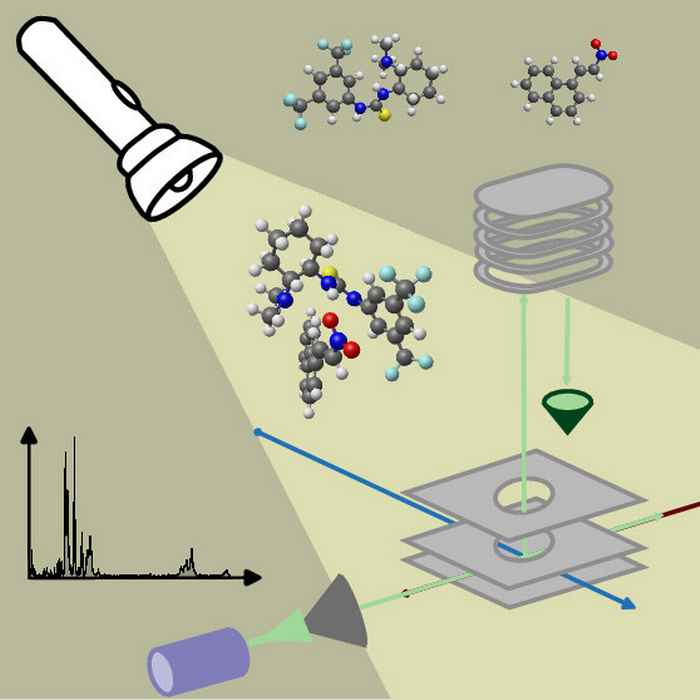Comprehensive infrared spectroscopy provides detailed insight into active organocatalyst
Catching reactive intermediates of catalyzed reactions on the fly
16 June 2025

The researchers have published their findings in a paper in the Journal of Physical Chemistry Letters. It paves the way for catching reactive intermediates of catalyzed reactions on the fly and thereby for the rational design of new and more efficient organocatalysts.
Allowing precise control
Catalysts are crucial components in chemistry, enabling chemical conversions in processes as diverse as food production, pharmaceutical synthesis and sustainable energy. Many catalysts are metal-based which can render them expensive, environmentally unfriendly and often toxic. Recent years have seen the emergence of organocatalysts, small metal-free molecules that have the potential to be cheap, stable, safe, and environmentally friendly. These can also provide a high enantioselectivity, allowing precise control over the formation of preferred conformational variants (enantiomers) of the same molecule - which is of utmost importance when it comes to biological activity.
In their recent paper, the Amsterdam-Nijmegen research team led by Prof. Wybren Jan Buma of Molecular Photonics present a successful approach to determine the precise molecular geometry of organocatalysts – in their native state as well as during catalytic activity, when binding a reactant.
They investigated the mode of action of ‘Takemoto’s catalyst’ as an example of a class of organocatalysts that operate in an enzyme-like fashion, relying on multiple hydrogen bonds to bind reactants in a fixed conformation. Obtaining precise and reliable information on the catalyst's structure and the relevant inter- and intramolecular interactions is crucial for the rational design of new and more efficient organocatalysts.
More challenging, better results
The method presented by Buma and co-workers relies on infrared spectroscopy using the FELIX free-electron laser of the HFML-FELIX institute, operated by the Dutch Research Council NWO.

Obtaining infrared fingerprints of intermediates involved in catalytic reactions has been possible before, but only for ionic species which are much easier to handle and manipulate. Studies on reactions involving neutral species have so far remained out of reach.
The experiments were carried out by merging a molecular beam of catalyst and reactant with the infrared laser light of FELIX, which gives access to a wide spectral range (from 650 up to 3500 cm-1). Key fingerprint vibrational features of the catalyst itself are found in this range, as well as vibrational modes that are sensitive to the subtle interactions with the nitroolefin reactant. The researchers combined the obtained detailed IR fingerprints (of structure, intra- and intermolecular interactions, and hydrogen bond formation) with quantum chemical calculations to arrive at an unequivocal characterization of the catalyst and the catalyst-reactant complex, in unprecedented detail.
‘Freezing out’ the reactive intermediate
It is important to realize that in the catalyst-reactant complex the catalyst must adopt a completely different structure that in the isolated catalyst has a much higher energy. The high collision rate conditions during the molecular beam expansion, however, enable to ‘freeze out’ the reactive intermediate that ultimately precedes the final outcome of the reaction. As such, the research has enabled elucidating the mode of action of the catalyst.
The present results are highly promising as they bring within reach, for example, similar studies on the reactive intermediates of catalytic reactions involving more than a single reactant. Furthermore, the presented methodology is broadly applicable, thereby breaking new ground for similar studies on a wide range of other relevant organo- and metallo-catalyzed reactions of which reactive intermediates have so far remained elusive.
Paper details
Piero Ferrari, Alexander K. Lemmens, Wybren Jan Buma: Light on catalytic reaction mechanisms: uncovering the conformation of thiourea-based organocatalysts and their interaction with nitroolefins using mid-infrared spectroscopy. J. Phys. Chem. Lett. 2025, 16, xxx, 6178–6184 DOI: 10.1021/acs.jpclett.5c01093